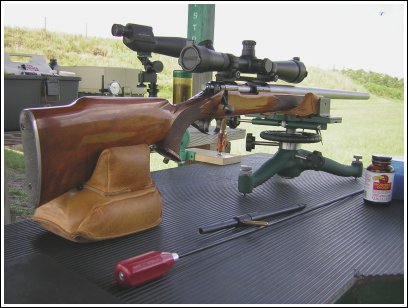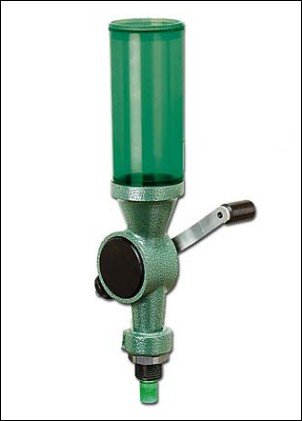How Much Powder?
There are a lot of different things that will improve the
accuracy of your handloads. Using "exactly" the right amount of
powder is one of the more important things. Before I decide how
much powder to use, I always compare two or more reloading manuals to
decide which bullet weight to use, and I notice what is considered to
be the maximum load. Keep in mind that each barrel is unique,
and it will develop a different amount of chamber pressure compared to
other rifles.
 I begin by taking my reloading equipment to the
range, and I use a chronograph to measure the exact velocity of my
handloads. The first thing I do is assemble and fire a single
round that is well below the maximum load. I examine it for
pressure signs, then I test other rounds one at a time. Each
round after that is loaded with .3 grain
more powder. After each firing, I examine the primer for signs
of excessive pressure. When the edge of the primer becomes
completely flat, then it's time to stop increasing the load.
That indicates the maximum load for my particular rifle.
I begin by taking my reloading equipment to the
range, and I use a chronograph to measure the exact velocity of my
handloads. The first thing I do is assemble and fire a single
round that is well below the maximum load. I examine it for
pressure signs, then I test other rounds one at a time. Each
round after that is loaded with .3 grain
more powder. After each firing, I examine the primer for signs
of excessive pressure. When the edge of the primer becomes
completely flat, then it's time to stop increasing the load.
That indicates the maximum load for my particular rifle.
At this point, I shoot the first (5) shot group
with my maximum load. I then make 5 more rounds and reduce the
powder by .3 grains, and shoot another 5 shot group. I repeat
this process a few times while comparing the accuracy of several
lighter loads. Somewhere in this process, I'll find the velocity
range that delivers the best accuracy with my particular rifle and
bullet combination. This method works for me.
Don't jump to conclusions after
shooting one great group. Back it up by firing at least two more
groups. It's pretty rare for a shooter to just take a wild stab
at how much powder to use and discover a great handload that shoots
well in all rifles. When you're sure that you've found the most
accurate load, be sure to record that velocity. When a good
friend of mine Dwight Hall, is asked for accuracy tips, he'll always
reply "Velocity, Velocity, Velocity . . . . you've got to find the exact speed
that shoots best with your particular bullet - in your particular
rifle." Developing handloads with a chronograph is a definite
advantage. With this method you can test any another type of
powder by handloading to duplicate this exact velocity. You'll
almost always shoot the tightest groups at (or very near) this speed.
After you decide on the best powder, you'll also need to
experiment with different bullet seating depths, to see which setting
delivers the best accuracy.
 Here are a few other thoughts on the subject.
A chronograph will show you how little the velocity is affected
by a slight variation in powder charge. After you've decided on
a good load, there's rarely a need to weigh individual powder charges.
A good powder measure can drop consistent powder charges with
most types of powder. I reload for about a dozen different
calibers, and I've only found one caliber that requires powder charges
to be weighed for each and every round. This caliber is the 300
Whisper. Mine needs to have an extremely uniform velocity,
because even the slightest variation in velocity will have a major
effect on its trajectory. This is because my 300 Whisper shoots
a subsonic 220 grain bullet, and it has a scope that uses several 50
yard markings on the reticle.
Here are a few other thoughts on the subject.
A chronograph will show you how little the velocity is affected
by a slight variation in powder charge. After you've decided on
a good load, there's rarely a need to weigh individual powder charges.
A good powder measure can drop consistent powder charges with
most types of powder. I reload for about a dozen different
calibers, and I've only found one caliber that requires powder charges
to be weighed for each and every round. This caliber is the 300
Whisper. Mine needs to have an extremely uniform velocity,
because even the slightest variation in velocity will have a major
effect on its trajectory. This is because my 300 Whisper shoots
a subsonic 220 grain bullet, and it has a scope that uses several 50
yard markings on the reticle.
Back when I was shooting in snow country, I once
discovered a surprising amount of unburned powder lying on the snow, in
front of where I was shooting. This shows that it's possible to
burn too little of a slow burning powder, before you run out of barrel
length. It's also important to use magnum primers with the large
calibers that require them. Speaking about primers . . . .
if your primer pockets loosen up, it almost always indicates that
you're handloads are generating too much chamber pressure. Try
using a different powder or just back your load down a bit.
